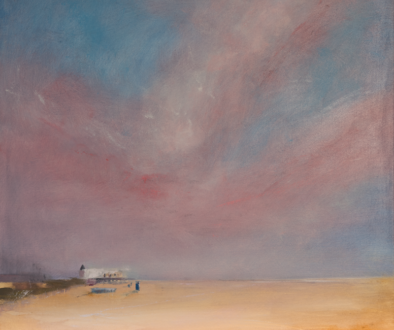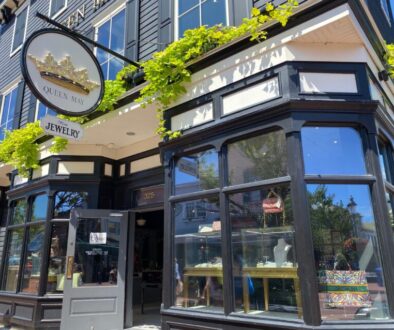1211 New Jersey Avenue

December, 1936… Dear Friends, enclosed is a picture of my Cape May cottage to which you are all invited to spend Fourth of July 1937 with me – remain two nights at least. I look forward to your coming with much pleasure indeed. Sincerely, Eleanor B. Gillespie
“My mother, Katherine M. Fiskett, purchased this house at 1211 New Jersey Avenue in 1999, and it has now passed to my siblings and me,” said Ellen Potter. “A photo of the house was featured in Cape May Magazine last spring as the Parting Shot photograph at the back, and my mom was thrilled. And so, she really wanted to see the house featured in Cape May Magazine for Christmas, but she passed at the end of 2022 before she could see it. And we still wanted the home featured.”
The house at 1211 New Jersey Avenue shines as an example of Cape May’s historic preservation efforts, as well as Katherine’s personal stewardship. As a Cape May lover, I am glad I was able to feature this timeless property and to hear some of the stories.
The property features two well-kept structures, gardens that are resplendent through four seasons, and a charm that you can feel from the street.
“My parents always wanted a second home, and we grew up outside Philadelphia. A lot of my mom’s friends had places in Ocean City then, and they told her to buy there,” Ellen told us. “But one day I was watching this documentary on Cape May – this was 1998 or so. I didn’t know anything about Cape May, but I said to my mom, ‘You’ll really like this place, it’s so beautiful, historic, and unique.’ So, we took a ride down and that was it. She got hooked up with Sotheby’s Real Estate and saw a few Victorians, but they needed too much work. Then we pulled up in front of 1211 New Jersey Avenue and we just looked at each other. I said to her ‘This is the one, isn’t it?’ And she said ‘Yes, but don’t say anything!’”
A 2018 historical survey provided by the City of Cape May describes the house as a “two-story, irregular-plan, frame, wood shingle-clad, Craftsman-style dwelling with a steeply pitched, cross-gabled roof.”
This house is a contributing property in the historic district because it “retains integrity and key character-defining historic features, such as its historic massing and fenestration patterns, its historic basement windows in some locations, its historic front and side doors, and its historic garage.” Both historic and elegant, the main entrance is at the top of added flared stairs and includes a historic wood door with a nine-light top section in an arched opening. Fenestrations refer to the thoughtful placement of the windows and doors in a building.
“Many years ago—it was 2007—we found an envelope stuffed in the front door of my mother’s home,” began Ellen, relating a story on how a postcard from 1936 made its way home to New Jersey Avenue.
“Inside were several items, including a cute Victorian Christmas card, dated 2007, from a woman identifying herself as an antique dealer in Pennsylvania. With the Christmas card was a handwritten note, along with a photo and a second Christmas card dated 1936. The note said ‘I came across this antique Christmas card from the 1930s and it has your house on it. I think the card was sent by the original owner, Eleanor B. Gillespie.’
The second Christmas card contained the text that serves as the introduction to this article. Oh, to have been a friend of Eleanor’s.
“There’s also a little black and white photo of Eleanor and the house and there is nothing around it,” said Ellen. “It’s just all land. And we’re pretty sure Eleanor was the first owner.”
The neighborhood around the house remained largely undeveloped into the early part of the 20th century when the East Cape May Improvement Company began development of the land east of Madison Avenue. The flagship of this large development was the Hotel Cape May (later the Admiral and then the Christian Admiral Hotel). New Jersey Avenue, extending northeast from Madison, is part of the grid laid out for the East Cape May development. The Hotel Cape May was erected between 1905 and 1908 and was the world’s largest hotel with 333 guest rooms when it opened in 1908. The hotel was part of a project intended to bring wealthy visitors to the city and make it a rich man’s destination in the style of Newport. But the hotel came in late and was over budget. It changed hands several times, never really made it, and was demolished in 1996.
“If you look at this house, you can tell the other houses around it are not that old,” said Ellen. “It looks like it was the only house on the block at the time.”
Elizabeth Cormier, Ellen’s sister, shared what she discovered.
“Eleanor B. Gillespie, of Wilmington, Delaware, was the first owner of our family beach house which she purchased on the 28th of September 1933,” wrote Elizabeth. “The Star and Wave newspaper ran an advertisement placed by the City of Cape May two times; once the week of August 10 and again the week of August 17, 1933. Ms. Gillespie in response to the ad paid the City of Cape May $600 for the deed to 1211 New Jersey Avenue. Almost 20 years later Eleanor Gillespie died in April 1952 and the house was then sold by a trust company, where the money from that sale was distributed to her heirs in accordance with her will’s direction.”
The home welcomes visitors with nice amenities including a fireplace, a sunroom nook, a new kitchen, and a large, screened porch.
“My mom purchased it from a young couple that was moving to California, and she made settlement around Labor Day weekend 1999,” said Ellen. “Ironically, mom wasn’t a big beach person, but she loved her house. And she loved decorating it and she really enjoyed that beach cottage style.”
The house is a testament to the two women who owned it and the ones in whose care it remains.



